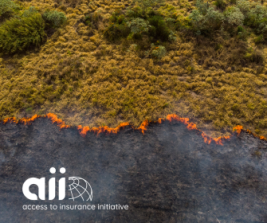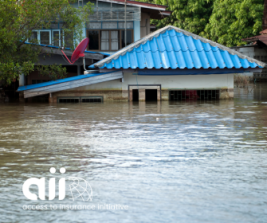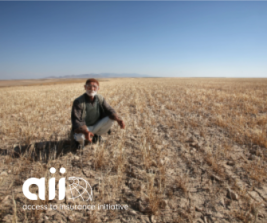Supervision of climate-related risks in the insurance sector
Supervision of climate-related risks in the insurance sector

COP26 begins today. Climate change is no longer seen as a projection for emerging or new risks but an ongoing reality that threatens the stability of the financial system and the insurance sector as a whole.
As part of its series of dialogues in 2021, the A2ii with IAIS co-hosted a discussion that was based on the IAIS and Sustainable Insurance Forum (SIF) joint Application Paper on Supervision of Climate-related Risks in the Insurance Sector. The co-chairs of the SIF/IAIS drafting team, Peter Kohlhagen and Emmanuel Rocher presented highlights from the Application Paper. This is an overview of the discussion, including some key recommendations for supervisors.
Supervisors are increasingly recognising the importance of their role in addressing climate risks. In some jurisdictions, supervisory authorities have launched various initiatives to address climate-related risks in their markets. In Morocco, Autorité de Contrôle des Assurances et de la Prévoyance Sociale (ACAPS) has been developing a framework to encourage insurers to integrate climate-related risks into their risk management systems. On the other hand, the South African Reserve Bank (SARB) Prudential Authority Climate Think Tank (PACTT) seeks to promote, develop, and coordinate the Prudential Authority’s regulatory and supervisory response to climate risks. To ensure the proper functioning, stability and development of its insurance market, the Comisión para el Mercado Financiero (CMF) in Chile has recently launched a Climate Change Strategy. The main objective of the strategy is to promote the disclosure of risks associated with climate change, promote the integration of climate risks into the management of financial system risks and promote the development of a green financial market.
How insurers can drive climate resilience
The risks associated with climate change fall into two categories: physical risks arising from climate trends (e.g. sea-level rise) and related extreme events, and transition risks associated with the transition to a low-carbon economy which may trigger among other things, new market dynamics and policy changes.[1]
While climate change poses a number of risks for the insurance sector, it also presents opportunities for the sector to build resilience. Within its role as a risk manager, a risk carrier and a risk investor, the insurance industry is well placed to build resilience against the impacts of climate change and support the transition to a low carbon economy.
...there are important opportunities that arise from this transition if we look at it from the lens of some of the insurers' roles in the financial market and in society. - Peter Kohlhagen
Key recommendations for supervisors
In addition to supporting supervisors in integrating climate risk considerations in their work, the Application Paper on Supervision of Climate-related Risks in the Insurance Sector also provides recommendations and examples of good practice for insurance supervisors to manage the challenges arising from climate change in line with the Insurance Core Principles (ICPs) across five main areas:
-
Supervisory review and reporting: Climate-related risks are a source of financial risks that may affect the resilience of insurers. It is recommended for supervisors to assess the relevance of climate-related risks to their supervisory objectives. ICP 9 (supervisory review and reporting) is seen as a good starting point. Notably, supervisors should collect quantitative and qualitative information on the insurance sector’s exposure to, and management of, physical, transition and liability risks of climate change (see p. 13 – 14 for examples of relevant indicators and sources of information). Where there is a lack of or limited availability of data, supplementary information may fill this gap. To streamline information gathering, it is recommended that supervisors look at mechanisms that will facilitate cross-border and cross-sectoral cooperation of supervisory review and reporting.
-
Corporate governance, risk management and internal controls: Supervision from a climate risk lens sets the expectation that insurers integrate climate-related risks into their overall corporate governance framework, including the risk management system and internal control functions (see ICP 7 and 8). For instance, as the understanding of climate risk evolves, some insurers have created special roles such as Chief Climate Risk Officer as part of their boards, and as it relates to such functions as the internal audit function, some supervisors have issued guidance on the including climate risk considerations into fit and proper assessments for board members of insurers (see pg. 20 for examples of supervisory practice on Corporate Governance, Risk Management and Internal Controls)
-
Enterprise risk management for solvency purposes: Of importance here is an insurer’s underwriting policies and processes and their Own Risk and Solvency Assessment (ORSA) related to ICP 16. Supervisors should expect insurers to consider physical, transition and liability risks arising from climate change in their ORSA process and in the same breath, adopt appropriate risk management actions to mitigate the identified risks (see pg. 25 – 28 for examples of supervisory practices on ORSA and stress testing). In addition, it is expected that insurers assess the implications of climate-related risks for their underwriting strategies and develop policies and procedures to integrate the management of these risks into their enterprise risk management.
-
Investments: Given the impact (whether direct or indirect) of physical and transition risks on an insurer’s investment portfolio, including their asset-liability management, it is important for supervisors to assess whether insurers incorporate the potential impacts of climate risk into their investment decisions. For insurers, a forward-looking view with quantitative and qualitative data, including use of scenarios may help them understand how their investments may be impacted in different climate scenarios (see pg. 30 for examples of supervisory practice on Investments).
-
Disclosures: It follows from ICP 20 (Public Disclosure), that material risks associated with climate change should be disclosed by insurers. Disclosure meets a key objective – that policyholders and market participants have a complete understanding of the financial condition of an insurer. Supervisors may use the Financial Stability Board (FSB) Task Force on Climate-related Financial Disclosures (TCFD) framework when designing best practices or as input for setting their supervisory objectives (see pg. 33 – 37 for examples of supervisory practice on Disclosure requirements). On the other hand, an insurers’ disclosure should encompass and describe the following elements: the general disclosure elements, the company profile, the corporate governance framework, the insurance risk exposures and the financial investment and other investments (see pg. 32 – 33 for more).
For greater detail on the above key areas and recommendations for supervisors, the joint IAIS and SIF Application Paper can be found here.
Going forward, it remains evident that climate-related risks will impact insurers and hence the need to build resilience to such risks. For supervisors, it is within their role to understand these risks and tap into available supervisory tools to monitor, assess and contribute to the mitigation of climate-related risks.
Keep up with the A2ii-IAIS Dialogues series by visiting our events. For resources on the topic of Climate and Disaster Risk, visit the A2ii Knowledge Hub. See our SDGs pages for an overview of A2ii work on SDG 13: Climate Action and additional resources for supervisors, and take part in the publicly available interactive training module on Connect A2ii based on the SIF-IAIS paper.
[1] See more in IAIS and SIF Issues Paper on Climate Change Risks to the Insurance Sector available here: https://www.iaisweb.org/page/supervisory-material/issues-papers/file/76026/sif-iais-issues-paper-on-climate-changes-risk
Share this article
Also in Blog





Authors
Posts by Author
Topics Cloud
Subscribe to our list
Receive notifications when we publish new blog entries
Subscribe here


